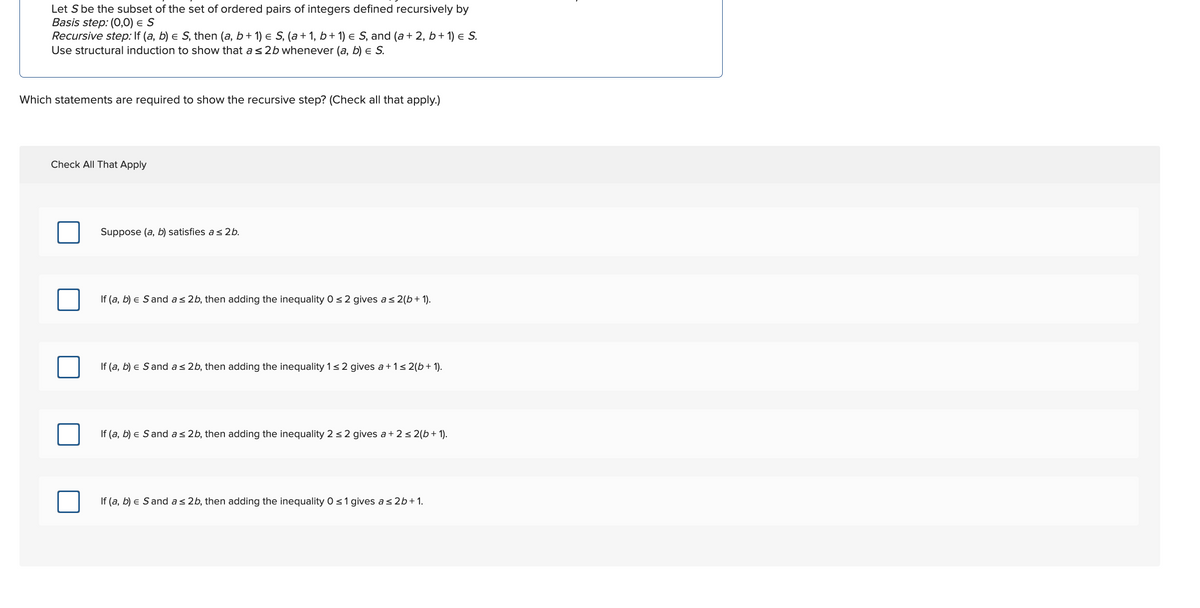Let S be the subset of the set of ordered pairs of integers defined recursively by Basis step: (0,0) € S Recursive step: If (a, b) e S, then (a, b + 1) e S, (a + 1, b + 1) e S, and (a + 2, b+1) € S. Use structural induction to show that as 2b whenever (a, b) e S. Which statements are required to show the recursive step? (Check all that apply.) Check All That Apply Suppose (a, b) satisfies as 2b. If (a, b) e S and a ≤ 2b, then adding the inequality Os2 gives a ≤2(b + 1). If (a, b) e Sand a ≤ 2b, then adding the inequality 1s2 gives a +1≤2(b + 1). If (a, b) e S and as 2b, then adding the inequality 2 s 2 gives a + 2 ≤ 2(b + 1). If (a, b) e Sand as 2b, then adding the inequality O s1 gives a ≤ 2b +1.
Let S be the subset of the set of ordered pairs of integers defined recursively by Basis step: (0,0) € S Recursive step: If (a, b) e S, then (a, b + 1) e S, (a + 1, b + 1) e S, and (a + 2, b+1) € S. Use structural induction to show that as 2b whenever (a, b) e S. Which statements are required to show the recursive step? (Check all that apply.) Check All That Apply Suppose (a, b) satisfies as 2b. If (a, b) e S and a ≤ 2b, then adding the inequality Os2 gives a ≤2(b + 1). If (a, b) e Sand a ≤ 2b, then adding the inequality 1s2 gives a +1≤2(b + 1). If (a, b) e S and as 2b, then adding the inequality 2 s 2 gives a + 2 ≤ 2(b + 1). If (a, b) e Sand as 2b, then adding the inequality O s1 gives a ≤ 2b +1.
Elements Of Modern Algebra
8th Edition
ISBN:9781285463230
Author:Gilbert, Linda, Jimmie
Publisher:Gilbert, Linda, Jimmie
Chapter2: The Integers
Section2.3: Divisibility
Problem 49E: 49. a. The binomial coefficients are defined in Exercise of Section. Use
induction on to prove...
Related questions
Question

Transcribed Image Text:Let S be the subset of the set of ordered pairs of integers defined recursively by
Basis step: (0,0) = S
Recursive step: If (a, b) = S, then (a, b + 1) = S, (a + 1, b + 1) = S, and (a + 2, b + 1) = S.
Use structural induction to show that a ≤ 2b whenever (a, b) = S.
Which statements are required to show the recursive step? (Check all that apply.)
Check All That Apply
Suppose (a, b) satisfies a ≤ 2b.
If (a, b) e Sand a ≤ 2b, then adding the inequality 0 ≤ 2 gives a ≤ 2(b + 1).
If (a, b) e Sand a ≤ 2b, then adding the inequality 1 ≤ 2 gives a +1 ≤2(b + 1).
If (a, b) e S and a ≤ 2b, then adding the inequality 2 ≤ 2 gives a + 2 ≤2(b + 1).
If (a, b) e Sand a ≤ 2b, then adding the inequality 0 ≤ 1 gives a ≤ 2b + 1.
Expert Solution
This question has been solved!
Explore an expertly crafted, step-by-step solution for a thorough understanding of key concepts.
This is a popular solution!
Trending now
This is a popular solution!
Step by step
Solved in 3 steps with 3 images

Recommended textbooks for you

Elements Of Modern Algebra
Algebra
ISBN:
9781285463230
Author:
Gilbert, Linda, Jimmie
Publisher:
Cengage Learning,

Algebra & Trigonometry with Analytic Geometry
Algebra
ISBN:
9781133382119
Author:
Swokowski
Publisher:
Cengage


Elements Of Modern Algebra
Algebra
ISBN:
9781285463230
Author:
Gilbert, Linda, Jimmie
Publisher:
Cengage Learning,

Algebra & Trigonometry with Analytic Geometry
Algebra
ISBN:
9781133382119
Author:
Swokowski
Publisher:
Cengage


Linear Algebra: A Modern Introduction
Algebra
ISBN:
9781285463247
Author:
David Poole
Publisher:
Cengage Learning

College Algebra (MindTap Course List)
Algebra
ISBN:
9781305652231
Author:
R. David Gustafson, Jeff Hughes
Publisher:
Cengage Learning